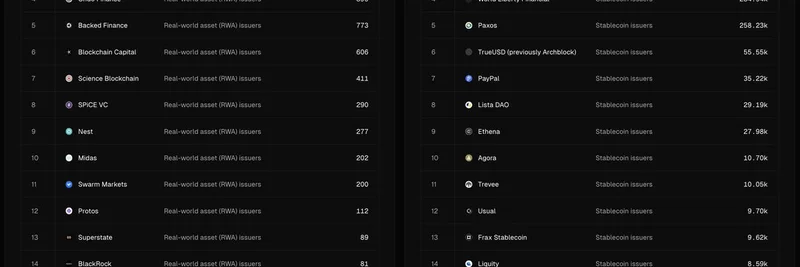Have you ever wondered why some crypto assets explode in popularity while others simmer on the back burner? A recent post from Token Terminal sheds light on this by comparing the number of holders for Real-World Asset (RWA) tokens and stablecoins. The data paints a clear picture: while stablecoins boast tens of millions of holders, RWAs are still attracting only a few thousand. This disparity underscores that we're just scratching the surface of asset tokenization in the blockchain world.
Token Terminal, a leading analytics platform for crypto fundamentals, shared this insightful chart on X (formerly Twitter). It highlights the top projects in both categories, ranked by the number of token holders.
Breaking Down the Data
Let's dive into the numbers. On the stablecoin side, giants like Tether lead the pack with a whopping 83.2 million holders. That's not surprising—Tether (USDT) is the go-to stablecoin for traders worldwide, maintaining a 1:1 peg with the US dollar. Following closely are Circle's USDC with 18.07 million holders and Sky (formerly MakerDAO's DAI) with over half a million.
In contrast, the RWA sector looks nascent. Republic tops the list with 7.45k holders, focusing on tokenizing real-world investments like startups and real estate. Projects like Spiko and Dinari follow with around 1.85k and 1.26k holders, respectively. These RWAs represent tokenized versions of traditional assets, such as bonds, commodities, or property, brought onto the blockchain for easier access and liquidity.
The gap is massive: stablecoins have achieved mainstream crypto adoption, while RWAs are still building their user base.
What Are Stablecoins and Why Do They Dominate?
Stablecoins are cryptocurrencies designed to minimize volatility by pegging their value to stable assets like fiat currencies or gold. Think of them as digital dollars that you can send across borders instantly without the wild price swings of Bitcoin or Ethereum. Their popularity stems from practical uses:
- Trading and Liquidity: Traders use stablecoins to park funds during market dips or to facilitate quick swaps on exchanges.
- Remittances and Payments: In regions with unstable local currencies, stablecoins offer a reliable alternative for sending money.
- DeFi Integration: They're the backbone of decentralized finance (DeFi), enabling lending, borrowing, and yield farming.
With billions in market cap, stablecoins like USDT and USDC have become household names in crypto, attracting millions of users globally.
Understanding Real-World Assets (RWAs)
RWAs take things a step further by tokenizing tangible assets from the real world onto the blockchain. This could include anything from real estate deeds to fine art or even government bonds. The idea is to make these assets more accessible, divisible, and tradable without traditional intermediaries.
For instance:
- Republic: Democratizes investment in private markets by tokenizing equity in startups.
- Ondo Finance: Specializes in tokenized US Treasuries, offering yields backed by real government securities.
- BlackRock's Involvement: Even traditional finance giants like BlackRock are dipping toes into RWAs, signaling institutional interest.
However, RWAs face hurdles like regulatory compliance, which slows adoption. Unlike meme tokens that can go viral overnight through social hype, RWAs require trust in the underlying assets and legal frameworks.
Why the Disparity Matters for Blockchain Practitioners
This holder gap highlights a key opportunity in the crypto space. Stablecoins have proven that blockchain can handle massive scale for value storage and transfer. Now, RWAs aim to bridge the gap between traditional finance and crypto, potentially unlocking trillions in tokenized assets.
But why should meme token enthusiasts care? Well, the rise of RWAs could influence the broader ecosystem. Imagine meme projects incorporating RWA elements, like backing a fun token with real-world yields. Or, as adoption grows, it could bring more liquidity and users into the space, benefiting everyone from DeFi degens to meme coin flippers.
Token Terminal's data reminds us: asset tokenization is still in its early days. With advancements in regulations and tech, we could see RWA holders skyrocket, much like stablecoins did a few years ago.
If you're into blockchain trends, keep an eye on platforms like Token Terminal for more data-driven insights. What's your take—will RWAs catch up to stablecoins soon? Share your thoughts in the comments!



